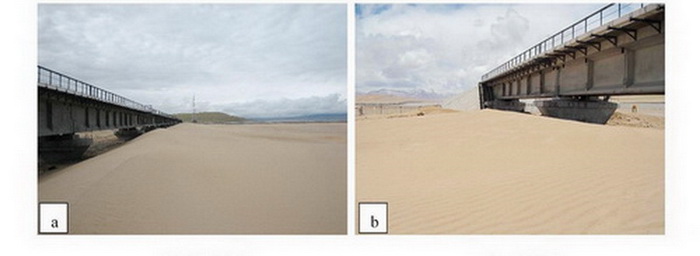Scientists Research the Sand Damage Control along the Qinghai-Tibet Railway
Updatetime:2014-08-21From:
【Enlarge】【Reduce】
With the railway’s operation on the Qinghai-Tibet plateau in recent years, the sand prevention research has been unfolded gradually. Due to the unique environment on the Qinghai-Tibet Plateau, any tiny change could disturb the ecosystem balance between the substance and the energy.
During the construction of the Qinghai-Tibet Railway, the vegetation and ecosystem on Qinghai-Tibet Plateau were disrupted at different levels. The railway’s construction also aggravated the wind-sand activity in near-surface ground.
Especially after the completion of the Qinghai-Tibet Railway, the railway’s roadbed and auxiliary facilities disturbed the relatively stable dynamic balance of wind-sand activity on the plateau, and the flow field structure of wind-drift sand in near-surface ground was also changed.
According the statistical data, there are 440km road damaged by sand along the Qinghai-Tibet Railway. Wind-sand threatened the railway’s roadbed and buried the rails. This condition impacted the safety operation of Qinghai-Tibet Railway seriously.
According to the field investigation and the lab analysis, scientists with the Cold and Arid Regions Environmental and Engineering Research Institute (CAREERI) researched six sections along the railway, namely Hongliang River, Xiushui-Beilu River, Tuotuo River, Tongtian River, Zhajiazangbu and Cuona Lake, and put forward to the advises to prevent the wind-sand damage.
The research aims to deepen the understanding of sand damage along the railway in high altitude and cold areas, and provides the basis for sand prevention along the Qinghai-Tibet railway.
It is suggested that the sand prevention along Qinghai-Tibet railway should be carried out by biological measures, and the vegetation should be restored by means of mechanical measures.
This research is financially supported by the National Natural Sciences Foundation of China (40930741), the Main Direction Program of Knowledge Innovation of Chinese Academy of Sciences (KZCX2-YW-329) and the Young Talent Foundation of CAREERI (51Y351121), and this research has been published on the Journal of Arid Land Resources and Environment, on July. 2014.

Fig. Sand damage in the bridge sections of Cuona Lake (Image by CAREERI)
Appendix




